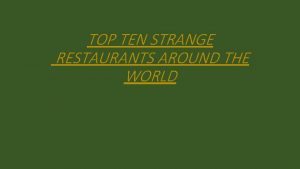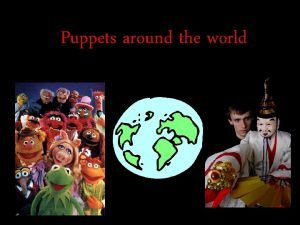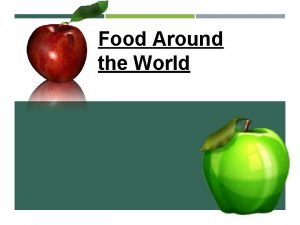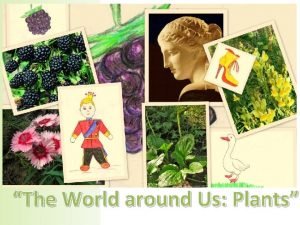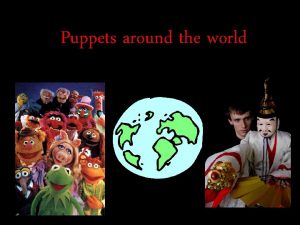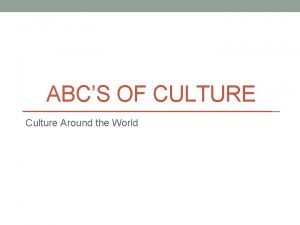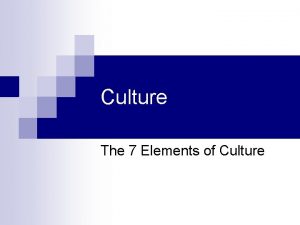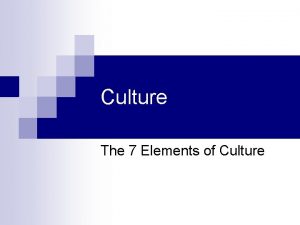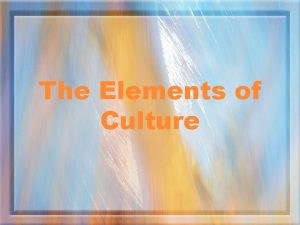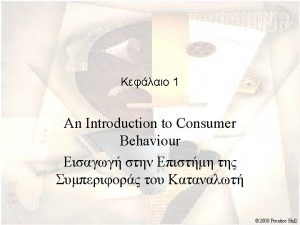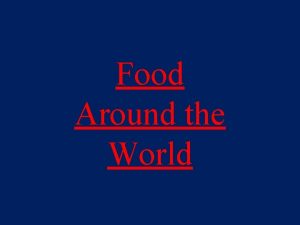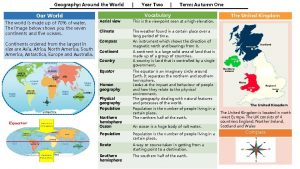Food Around the World Elements of Food Culture
























- Slides: 24

Food Around the World

Elements of Food Culture & cuisine • Culture refers to a group’s pattern of behaviors: • Thought • Belief System • Language • Actions • Production of goods, artifacts, & art

• Culture is considered part of our civilization, often referring to an area’s advancements in: • Science • Technology • Art • Government • Spirituality

• Food Culture: • Describes the way in which a particular group of humans think about food and how they think and cook that food

• Progression of Food Culture • Primitive civilizations lack technology to have stable/abundant food supply • Spend more time searching for food • Prepare food quickly with less thought • Little to no time practicing new dishes

• Progression of Food Culture • Advanced civilizations have a stable/abundant food supply • Specialization of Labor = More leisure time and wealth • More time & wealth to cook more complex dishes • Cooking becomes CUISINE

• Cuisine is the skilled, thoughtful, refined cooking belonging to a particular style.

• Food cultures and resulting cuisines based on 3 elements: • Ingredients • Cooking Methods • Attitudes about Food & Eating

• Ingredients • Foundation Foods • Comprise a food culture’s principal starches, proteins, & produce • Starches & grains are usually most important in most civilization’s as they form the bulk of the human diet

• Ingredients • Seasonings • Herbs, spices, & condiments

• Ingredients • Cooking Media • Contribute to flavor & determine cooking methods • Examples: Fats for frying, liquids for poaching & stewing, etc.

• 2. Cooking Methods • Application of Heat • How heat is applied largely determines color, texture, & flavor • Sole reason for fire = Heat • Now = Evaluate cooking techniques of a culture can be linked to the culture’s heat technology development

• 2. Cooking Methods • Cooking Vessels • Types used affects heat conduction & flavor • Earliest food cultures used skin bags, animal stomachs, leaf wrappings, and flat stones • Now = Earthenware, Bronze, Steel, Aluminum, Stainless Steel, & new technological materials to make pots & pans

• 2. Cooking Methods • Cooking Media • Some cooking methods may depend on ingredients, as well as vessel technology • Example: Frying methods require frying fats & metal pots/pans Cultures that don’t use fats (either for preference or lack of availability), would not fry their food

• 2. Cooking Methods • Food Preservation • Essential element of many cuisines • Drying, curing with salt, preserving with sugar, smoking, sealing from air • Early history of preservation methods often strongly affect modern cuisine

• 3. Attitudes about Food & Eating • Fundamentally determine which ingredients & cooking methods are accepted/favored • Attitude toward food even more important than ingredients

• 3. Attitudes about Food & Eating • May be subtle, complex, and difficult to understand • Linked to Subconscious • May not even hold beliefs & attitudes about food without knowing why

• Preferences & taboos frequently linked to: • Social practices • Ethical beliefs • Spiritual beliefs

• Attitudes about Food & Eating • To fully understand a food culture, learn about their: • History • Culture • Religion





 Example of what goes around comes around
Example of what goes around comes around Martin luther king of hinduism
Martin luther king of hinduism Material and non material culture examples
Material and non material culture examples Individual culture traits combine to form culture patterns.
Individual culture traits combine to form culture patterns. Batch culture vs continuous culture
Batch culture vs continuous culture Fed-batch
Fed-batch Collectivistic cultures
Collectivistic cultures Indian vs american culture
Indian vs american culture Stroke culture method
Stroke culture method Folk culture and popular culture venn diagram
Folk culture and popular culture venn diagram A sub-culture group
A sub-culture group What is folk culture
What is folk culture Urease test
Urease test Folk culture and popular culture venn diagram
Folk culture and popular culture venn diagram Inert organizational culture
Inert organizational culture Stroke culture method
Stroke culture method Carpet culture microbiology
Carpet culture microbiology Quality culture changing hearts minds and attitudes
Quality culture changing hearts minds and attitudes Surface culture deep culture and esol
Surface culture deep culture and esol Weird restaurants around the world
Weird restaurants around the world School calendars around the world
School calendars around the world Puppets from around the world
Puppets from around the world Sunday psali
Sunday psali Madame tussauds around the world
Madame tussauds around the world Unit 2 around the world
Unit 2 around the world



















